“Contains no poisonous drugs or added poison.”
HOLTZERMANN’S PATENT STOMACH BITTERS
The Later 4-Roof Cabin
25 November 2012 (R•061814) (R•071714) (R•052917) (R•022518) (R•101818)
![]() Most bitters and figural collectors are very aware of the early 2-roof and later 4-roof molds for the rectangular Holtzermann’s Patent Stomach Bitters. Very few of us are aware of the history behind these bottles, including myself. I will start out today with the later bottle, the Ring/Ham H 154 4-Roof figural cabin. Do not expect to see a great array of colors as in the Old Homestead Wild Cherry Bitters as these bottles come in amber shades only. You will also see a great labeled example and a miniature in this post. I want to point out that Steve Sewell has done the lions share of earlier work on the Holtzermann family. His comments can be supported by other material I have reviewed online.
Most bitters and figural collectors are very aware of the early 2-roof and later 4-roof molds for the rectangular Holtzermann’s Patent Stomach Bitters. Very few of us are aware of the history behind these bottles, including myself. I will start out today with the later bottle, the Ring/Ham H 154 4-Roof figural cabin. Do not expect to see a great array of colors as in the Old Homestead Wild Cherry Bitters as these bottles come in amber shades only. You will also see a great labeled example and a miniature in this post. I want to point out that Steve Sewell has done the lions share of earlier work on the Holtzermann family. His comments can be supported by other material I have reviewed online.
H 154 HOLTZERMANN’S PATENT STOMACH BITTERS, Circa 1885 – 1895
// s // HOLTZERMANNS ( cu ) / PATENT / STOMACH / BITTERS // shingles // shingles // shingles // motif cabin // motif cabin // sp // motif cabin //
L…Holtzermannn’s Patent Stomach Bitters Compound, Ahrendt Sons Co.,
Sole Manufacturers, Toledo, Ohio
Ahrendt Sons Co. Sole Manufacturers Toledo, Ohio
9 3/4 x 3 3/8 x 2 3/4 (5 3/8)
Rectangular cabin, Amber, LTC, Applied mouth and Tooled lip, Common
Note: Realistic logs except between windows and between window and door. Letters of Holtzermann’s weakly embossed on most examples. There are some examples with very bold embossing with window panes showing. These examples are Scarce. This may be a different mold. There are at least four (4) variants with and without an apostrophe on Holtzermann’s.
Label: Established 1836. Recommended as a great appetizer and stomach tonic. Contains no poisonous drugs or added poison.
Advertised in 1889.
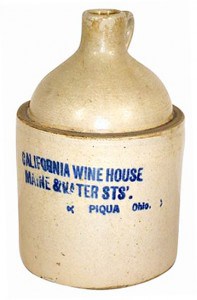 An advertisement with a bottle of Holtzermann’s Stomach Bitters set amongst fruit. “Holtzermann’s Stomach Bitters For Sale Here! J. D. Holtzermann & Sons, Wholesale Dealers in Foreign and Domestic Liquors. Cor. Of Main & Water Sts. Piqua, O.” No date. 17 x 22. Chromolithograph.
An advertisement with a bottle of Holtzermann’s Stomach Bitters set amongst fruit. “Holtzermann’s Stomach Bitters For Sale Here! J. D. Holtzermann & Sons, Wholesale Dealers in Foreign and Domestic Liquors. Cor. Of Main & Water Sts. Piqua, O.” No date. 17 x 22. Chromolithograph. *I am tying to track this down. From John Bartley: This was on display (see picture below) at an Ohio Bottle Club show a couple of years ago. I believe it belongs to Ted Christ. Using the same address, or at least on one of the other corners, “California Wine House/Main(e) and Water Sts./Piqua, Ohio.” (see picture to left)
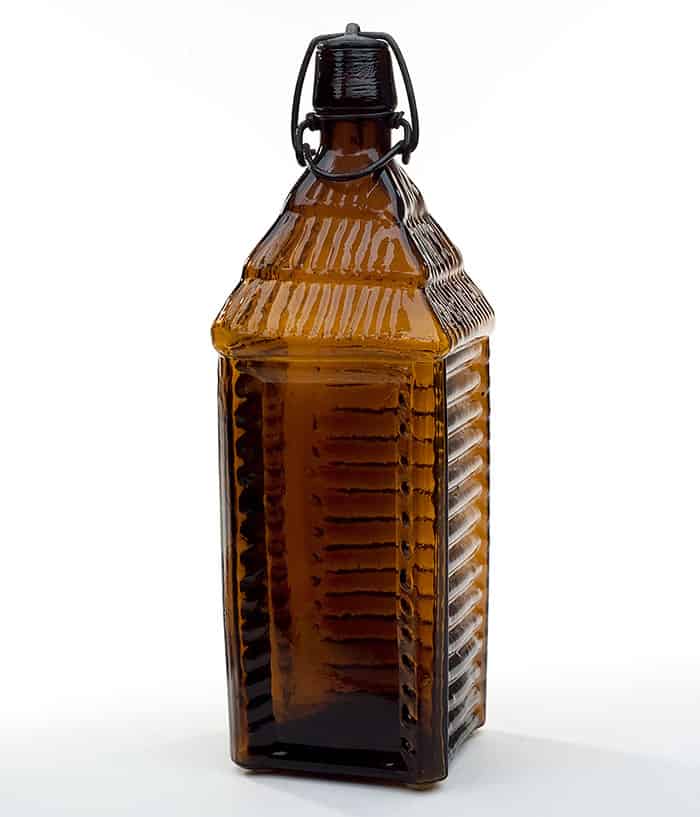
Look closely at the bottle in the framed picture above. Unembossed, pontiled, Cabin-Form Holtzermann Bitters, America, 1860 – 1865. Golden amber, square with beveled corners, one full-length label panel having large dots along the edge, applied sloping collar with lightning-type closure added at a later point – red iron pontil scar, ht. 9 7/8″, attic mint! An extremely rare mold, and while not unique, is believe to be one of only a handful known to exist. Very distinctive and different from the preceding lot with evidence suggesting that it was likely blown for the Holtzermann Bitters Co. – American Glass Gallery
AHRENDT & SONS CO. , Toledo, Ohio. 1890-1915, The company used the brand name: “Crack Shot.”, Business name timeline: Ahrendt & Hacker (1890-1895), Ahrendt & Sons (1900-1905), Ahrendt & Sons Co. (1906), The Ahrendt & Sons Co. (1914-1915), Address timeline: 604 Monroe (1890-1895), 522 Monroe (1900-1905), 512 Monroe (1906-1915) [pre-pro.com]

Patentees for the Year 1884 – Holtzermann’s Celebrated Patent Stomach Bitters – J.D. Holtzermann & Co., December 2, 1884 [4-roof]
Piqua was originally a small hamlet originally developed as a combination of log/frame homes, small shops, taverns and inns, and small family-based industries. Early crossroads began the community’s growth as a marketing center for the surrounding farm lands. The first brick residences were constructed along Main Street in 1819 and began the community’s true architectural history. The first local building style reflected Federal style elements with very little ornamentation. These local Federal Style homes were very restrained by today’s standards, but in the 1820s and 1830s reflected prosperity and high style.
The completion of a segment of the Miami & Erie Canal to Piqua in 1837 promoted the next growth period up through 1860. Canal traffic encouraged the construction of shops fronting on both Main Street and the canal. Imposing Greek Revival Style homes began to be built within two blocks to the east and west of Main Street. These new homes added a wealth of architectural detail to the same basic rectangular design of the earlier Federal Style. The local commercial versions of the Greek Revival Style during the 1840s and 1850s, with their plain stone lintels, were a bit more modest in their use of architectural detailing. However, the builders of these solid two and three story brick shops began to change the street scape of the town by filling in the vacant lots and demolishing the log and frame shops along Main Street.
This commercial growth began pushing the residential center to Wayne Street and the manufacturing center to Spring Street. The Columbus, Piqua and Indiana Railroad reached the downtown in 1856 and led to the led to the third building boom from 1860 through 1880. During this era, the Italianate style flourished in both residential and commercial variations. Two and three story brick shops with narrow and elongated windows were built on Main Street. The first and largest of these new Italianate buildings was completed in the 1860s on the northwest corner of the square. For the next twenty years this style dominated the downtown with its restrained yet prominent window hood molds and cornice brackets. The long narrow open floor shops filled the first floors while the upper floors were reserved for residences, offices, and lodge halls.
It was in this last growth spurt in the early 1860s that Christopher August Holtzermann went in to business a local domestic Liquor Merchant and Druggist who had a small store at the corner of Main and Water Streets. On May 7, 1867 Charles August Holtzermann patented his formula for bitters -composed of pure spirits, sugar, orange peel, orange apple, oms root, galanga root, gentian root, calamus root, wormwood, ginger, cardamon seed, cassia, mace, nutmeg, cloves, and coriander seed. [PRG: I do not think this information is correct]
In 1871 he advertised “Holtzermann’s Stomach Bitters For Sale Here! August Holtzermann Wholesale Dealer in Foreign and Domestic Liquors. Located on the Corner of Main & Water Streets. Piqua, Ohio”.
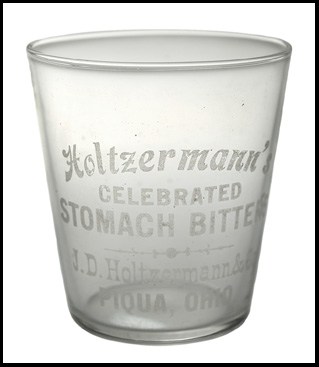
Bitters Shot Glass, ‘Holtzermann’s / Celebrated / Stomach Bitters / J.D. Holtzermann & Co. / Piqua, Ohio’, (Ring/Ham, H-154), Oho, ca. 1890 – 1900, clear glass with etched lettering, 2 1/4”h, smooth base, tooled rim. Perfect condition. Extremely rare, very few, if any collectors of bitters shot glasses will have this one! – Glass Works Auctions – Auction 119
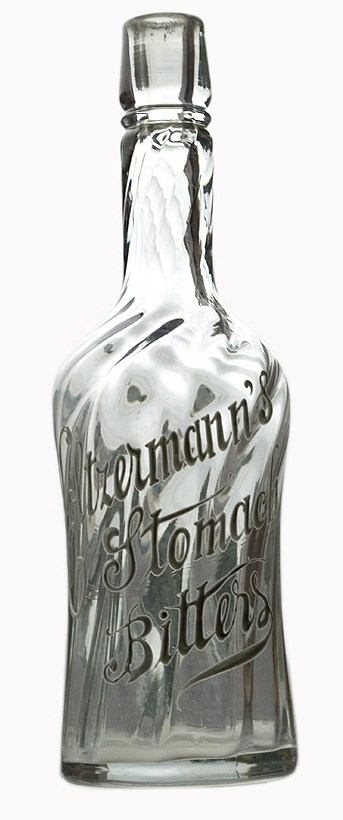
Back Bar Bottle, ‘Holtzermann’s / Stomach / Bitters’ (in white enamel script lettering), (Ring/Ham, pg. 285), Ohio, ca. 1885 – 1895, clear glass bottle, 10-vertical rib pattern twisted to the right, 11 1/8”h, smooth base, tooled lip. – Glass Works Auctions
Holtzermann’s Patent Stomach Bitters were very extensively sold throughout western Ohio, Indiana and Illinois.
The bitters were bottled in a two story (see above) Cabin Shaped bottle. Most Liquor merchants were still reeling from the Federal raids which had occurred in the late 1860’s on Liquor dealers who were accused of avoiding taxes on whiskey by simply calling their product bitters. Business went well and Christopher amassed a fortune in a short time. Business was still booming but Christopher fell ill in June of 1875. He never recovered and died a month later on Jul 6, 1875 in Piqua at the young age of 34. He was buried on July 7, 1875 in Forest Hill Cemetery, Piqua.
His son Louis J. Holtzermann was born on Sep 18, 1864, a second son Jacob Daniel Holtzermann was born on September 10th, 1869. With their fathers unexpected death first Louis and then Jacob were both forced to work at a very early age in the company store. Jacob was quite the business man by the age of 17 in 1886. He and his brother Louis were now expanding the business. J.D. Holtzermann & Co, Wholesale Dealers in Foreign and Domestic Liquors located at the Corner Of Main & Water Streets Piqua Ohio have sucessfuly opened a second business located in Minneapolis Minnesota. The large department store opened in 1887. They continued to carry the Bitters which had made them wealthy men at a young age.
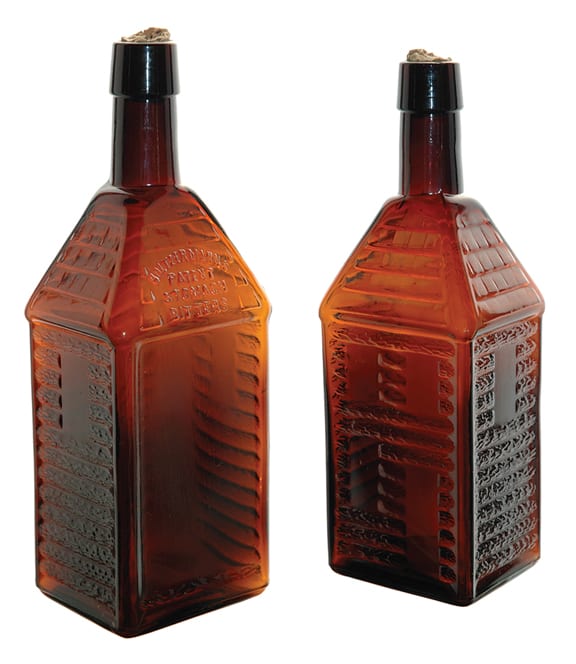 The two roof bitters bottle embossed Holtzermann’s on one roof panel and Patent Stomach Bitters on the other evolved into the 4 roof version which was embossed on one roof Panel Holtermanns Patent Stomach Bitters. The cabin design lasted until 1885 and then a completely different version a 4 sided square one (see above) like most of the other bitters bottles of the day. The 2 roof variants are somewhat rare and proof versions of those are extremely rare. The square shaped 1885 to 1910 version which is embossed Holtzermanns/ Stomach/ Bitters on one panel and then on the opposite panel the embossing reads J. D. Holtzermann & Co./ Piqua O. is actually listed by Ring and Ham as extremely rare (actually listed as common). A small salesmen sized ( 4 1/2 inches tall ) (*actually 4″) 4 roof cabin version is also a rare bottle. A back bar bottle with a twisted neck embossed Holtzermanns Stomach Bitters is also listed as a very rare bottle.
The two roof bitters bottle embossed Holtzermann’s on one roof panel and Patent Stomach Bitters on the other evolved into the 4 roof version which was embossed on one roof Panel Holtermanns Patent Stomach Bitters. The cabin design lasted until 1885 and then a completely different version a 4 sided square one (see above) like most of the other bitters bottles of the day. The 2 roof variants are somewhat rare and proof versions of those are extremely rare. The square shaped 1885 to 1910 version which is embossed Holtzermanns/ Stomach/ Bitters on one panel and then on the opposite panel the embossing reads J. D. Holtzermann & Co./ Piqua O. is actually listed by Ring and Ham as extremely rare (actually listed as common). A small salesmen sized ( 4 1/2 inches tall ) (*actually 4″) 4 roof cabin version is also a rare bottle. A back bar bottle with a twisted neck embossed Holtzermanns Stomach Bitters is also listed as a very rare bottle.
Ring and Ham in their book list the original proprietor of Holtermanns Bitters as J D (Jacob Daniel ) Holtzermann and stated it was he who took out the patent in 1867. This was immpossible as he was not born until the end of 1869. It was his father Christopher or August as he was known in the German Community who first patented the bitters. [end Steve Sewell] *?* Jacob Daniel Holtzermann
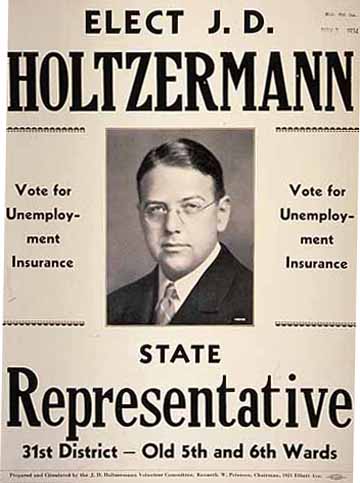 Jacob Daniel Holtzerman was also a Minneapolis Department Store owner (“Holtzermann’s Chicago Store” – Chicago was apparently added to the name to glamourize it) who held a Masters Degree in International Law from Harvard. He was and a minor state politician. He was also the publisher of an isolationist weekly, the Minnesota Beacon and was a supporter of America First and an acquaintance of Charles Lindbergh. Holtzermann’s father or uncle was born in 1869 in Piqua, Ohio, and held the patent on Holtzermann’s Patent Stomach Bitters, a preparation intended to aid digestion (and which may have contained alcohol) but which is now mostly known for the collectibility of the bottles it came in. He and his brother Louis came to Minneapolis in 1887 and opened the store. It’s not clear whether Jacob died young, but Jacob D. Holtzermann, born in 1902, was either the son or nephew of the first Jacob D. He graduated from the University of Minnesota in 1921, studied in Geneva and Munich, and received a Master’s in International Law from Harvard – and then came back and ran the store. He made numerous trips to Europe on buying expeditions. Whether because or in spite of his cosmopolitan outlook, Holtzermann was a staunch isolationist in the years leading up to World War II, and one of some influence, since he owned a local isolationist paper, The Minnesota Beacon. But unlike some America Firsters, he was not an anti-Semite. A Lutheran, he belonged to a local organization called the Roundtable of Christians and Jews (and this meant something, because Minneapolis was a very anti-Semitic city in those days). When Charles Lindbergh was making speeches which might have been open to interpretation as anti-Semitic, he wrote to the aviator urging him to repudiate such statements. Lindbergh did not. In later years Holtzermann was active in Republican politics and attempted to gain the nomination for State Senator in 1966; he died in 1969. The store closed a few years later. The building still stands and apartments in it are advertised as being in the “Historic Holtzermann Building.”
Jacob Daniel Holtzerman was also a Minneapolis Department Store owner (“Holtzermann’s Chicago Store” – Chicago was apparently added to the name to glamourize it) who held a Masters Degree in International Law from Harvard. He was and a minor state politician. He was also the publisher of an isolationist weekly, the Minnesota Beacon and was a supporter of America First and an acquaintance of Charles Lindbergh. Holtzermann’s father or uncle was born in 1869 in Piqua, Ohio, and held the patent on Holtzermann’s Patent Stomach Bitters, a preparation intended to aid digestion (and which may have contained alcohol) but which is now mostly known for the collectibility of the bottles it came in. He and his brother Louis came to Minneapolis in 1887 and opened the store. It’s not clear whether Jacob died young, but Jacob D. Holtzermann, born in 1902, was either the son or nephew of the first Jacob D. He graduated from the University of Minnesota in 1921, studied in Geneva and Munich, and received a Master’s in International Law from Harvard – and then came back and ran the store. He made numerous trips to Europe on buying expeditions. Whether because or in spite of his cosmopolitan outlook, Holtzermann was a staunch isolationist in the years leading up to World War II, and one of some influence, since he owned a local isolationist paper, The Minnesota Beacon. But unlike some America Firsters, he was not an anti-Semite. A Lutheran, he belonged to a local organization called the Roundtable of Christians and Jews (and this meant something, because Minneapolis was a very anti-Semitic city in those days). When Charles Lindbergh was making speeches which might have been open to interpretation as anti-Semitic, he wrote to the aviator urging him to repudiate such statements. Lindbergh did not. In later years Holtzermann was active in Republican politics and attempted to gain the nomination for State Senator in 1966; he died in 1969. The store closed a few years later. The building still stands and apartments in it are advertised as being in the “Historic Holtzermann Building.”
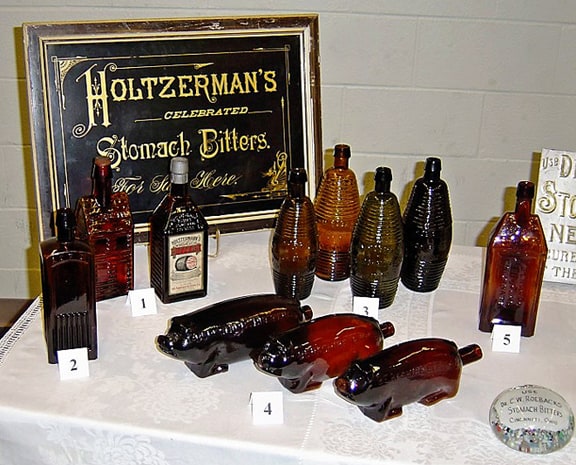
John Bartley: This was on display at an Ohio Bottle Club show a couple of years ago. I believe it belongs to Ted Christ.
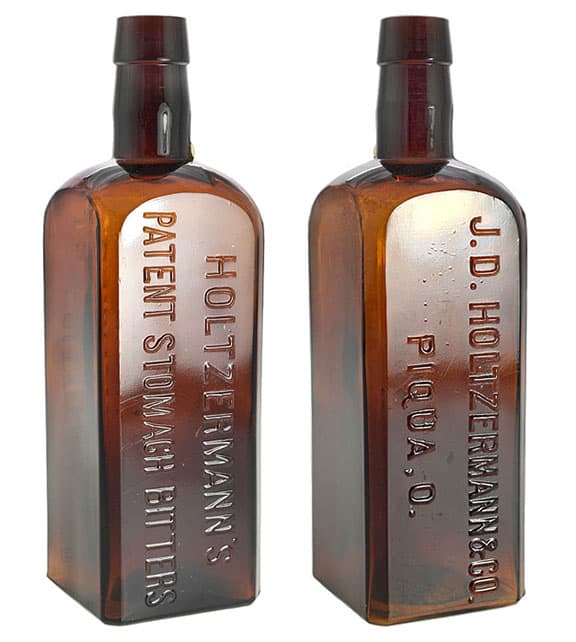
“HOLTZERMANN’S / PATENT STOMACH BITTERS – J.D. HOLTZERMANN & CO / PIQUA, O.”, (Ring/Ham H-155.5), Ohio, ca. 1880 – 1890, medium root beer amber, 9 3/8”h, smooth base, tooled mouth. CONDITION: About perfect, (a pinhead in size flake is off the outer edge of the lip). Extremely rare, one of only a very few known examples! – Glass Works Auctions #102

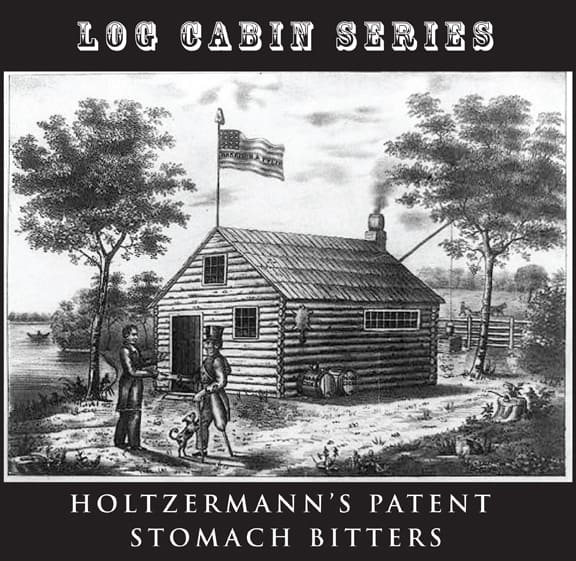
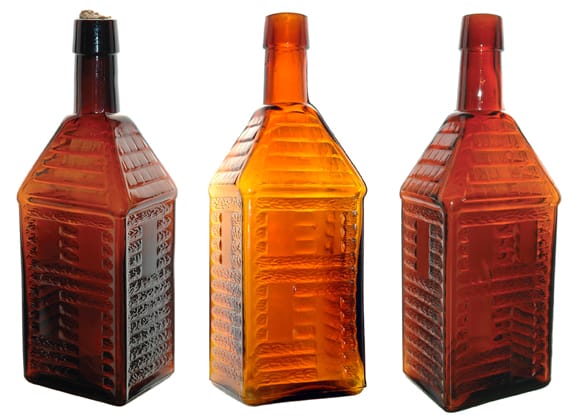
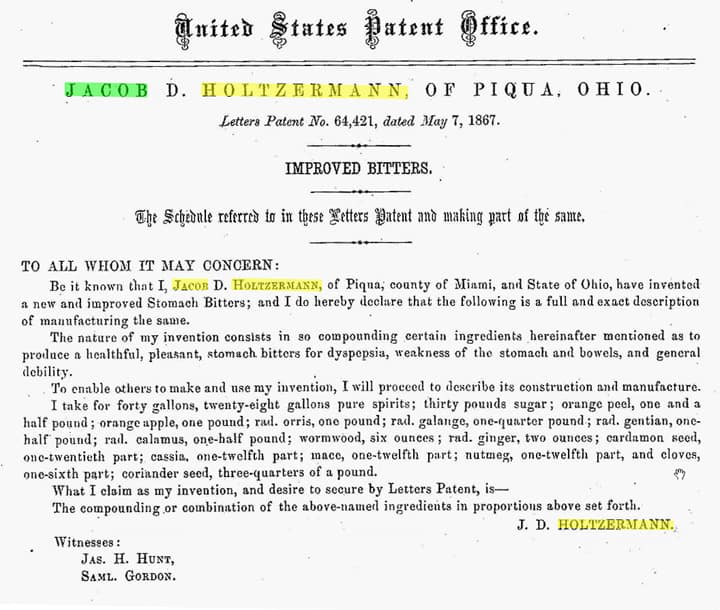
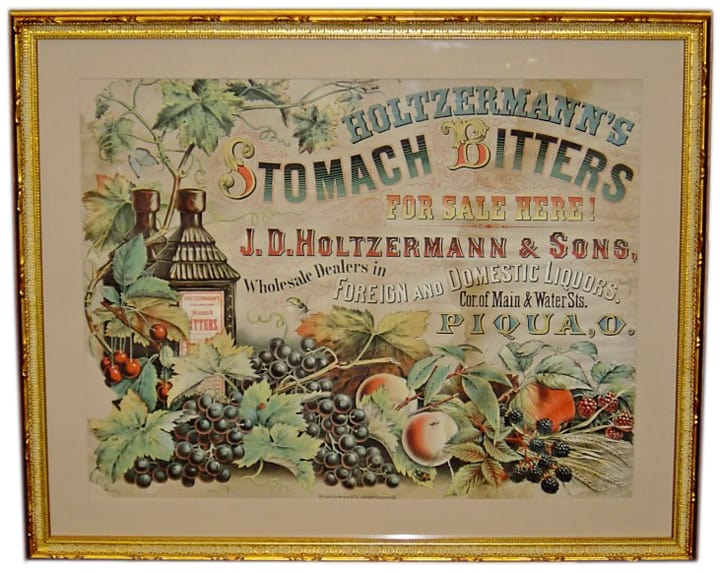
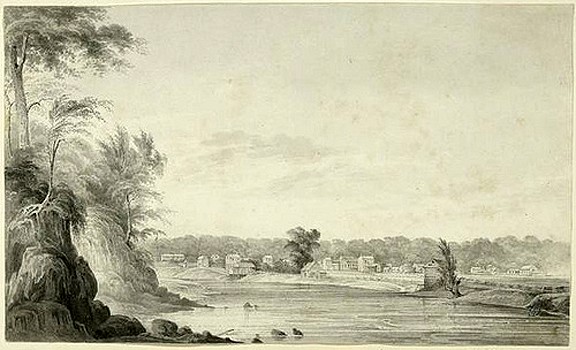
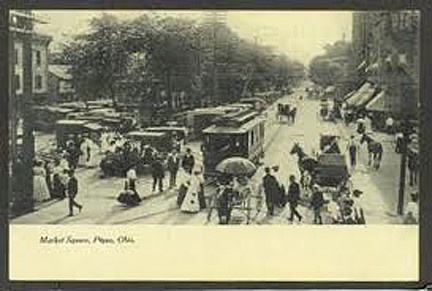
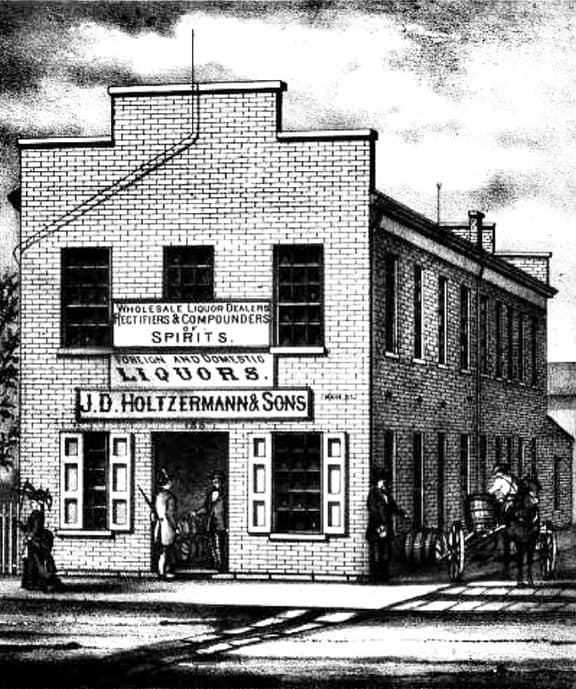
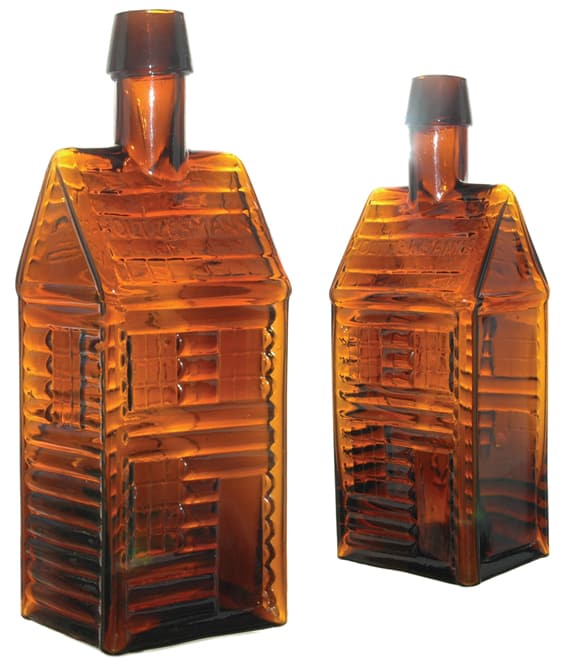
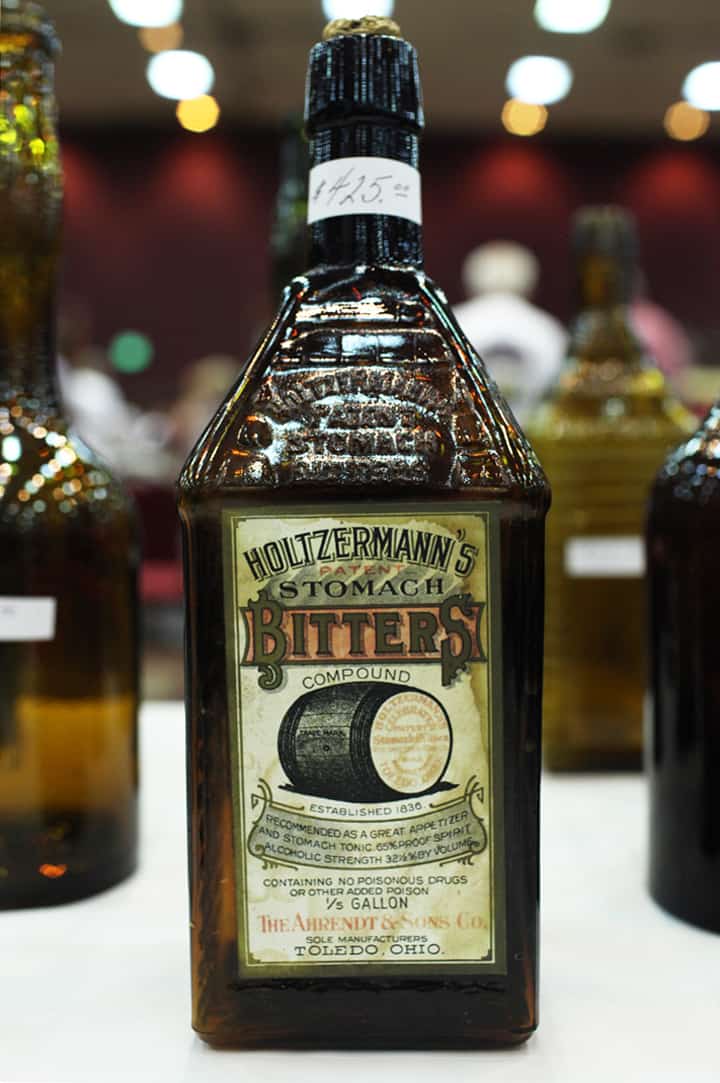
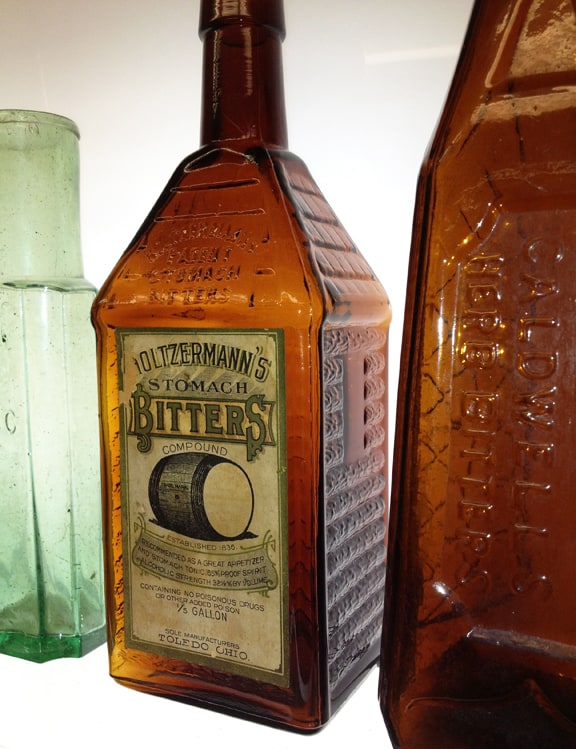
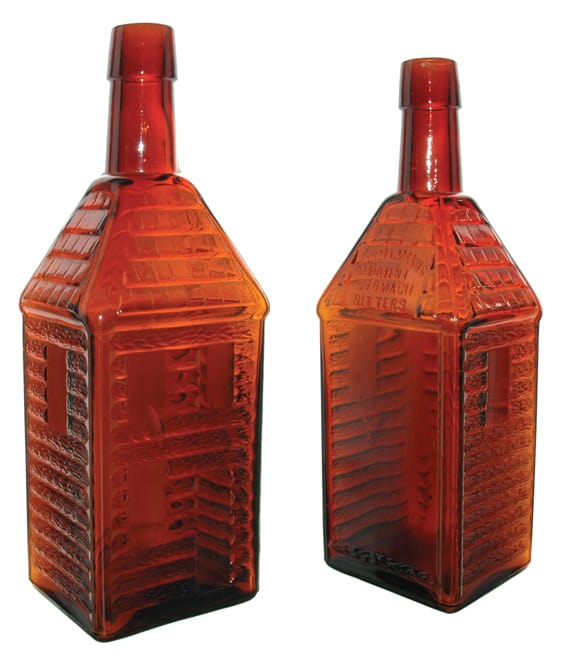
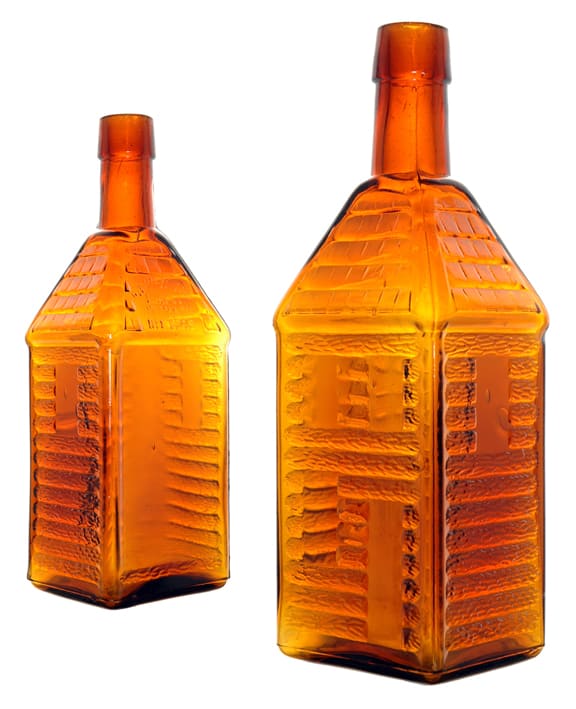
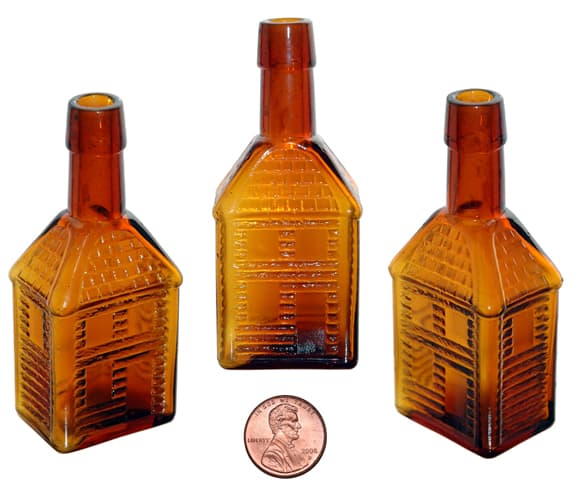
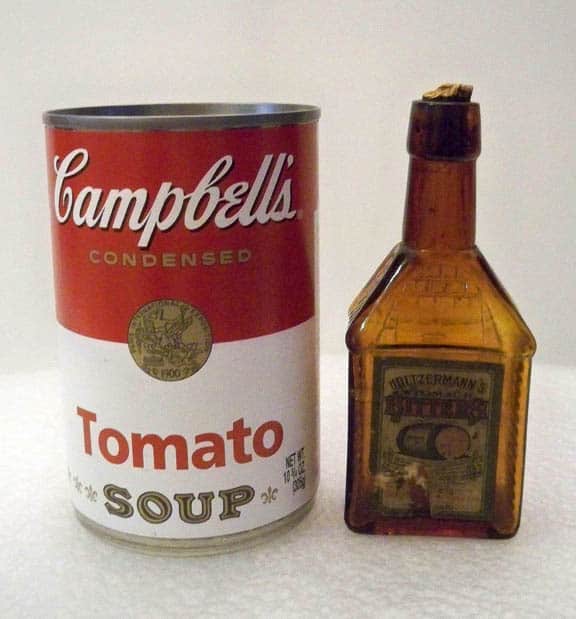
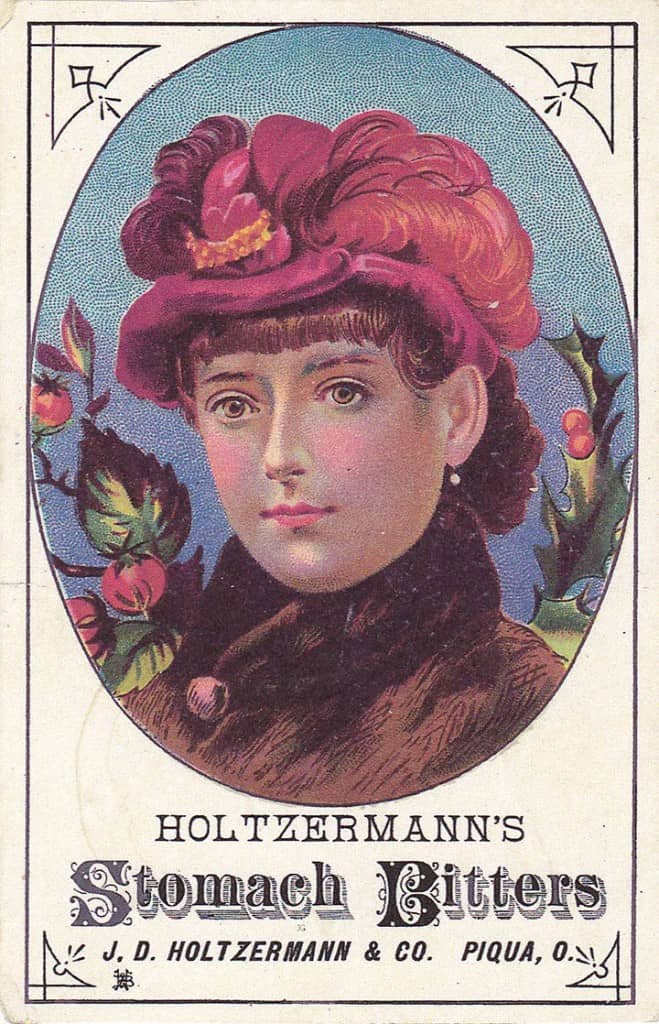
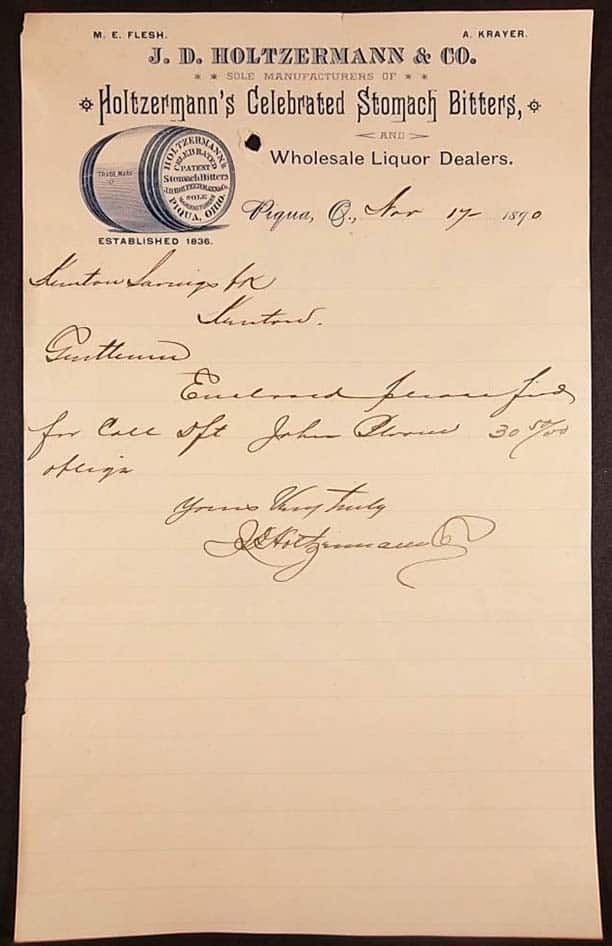







Hi Ferdinand,
During my pre disseminated histoplasmosis digging career we found at least three of the 4-roof Holtzermanns in very late pits in Toledo. They would be in mixed machine and tooled mouth holes which gave me the first indication that these were very late bottles. Prior to that I always assumed they were 1890’s instead of 1914-1915 as evidenced by the research in your post. The dangers of digging such as contracting histoplasmosis might be an interesting topic for discussion. Most diggers poopoo the chance at catching something like I did. Being in the hospital and almost dying will make you a believer. I was in Henry Ford hospital in Detroit for thirty days and not back to full strength for almost a year. Wearing a respirator with cartridges is the only way to protect yourself.
Jamie Houdeshell
Added picture of labeled HOLTZERMANN’S PATENT STOMACH BITTERS found on ebay with Campbell’s Soup Can.